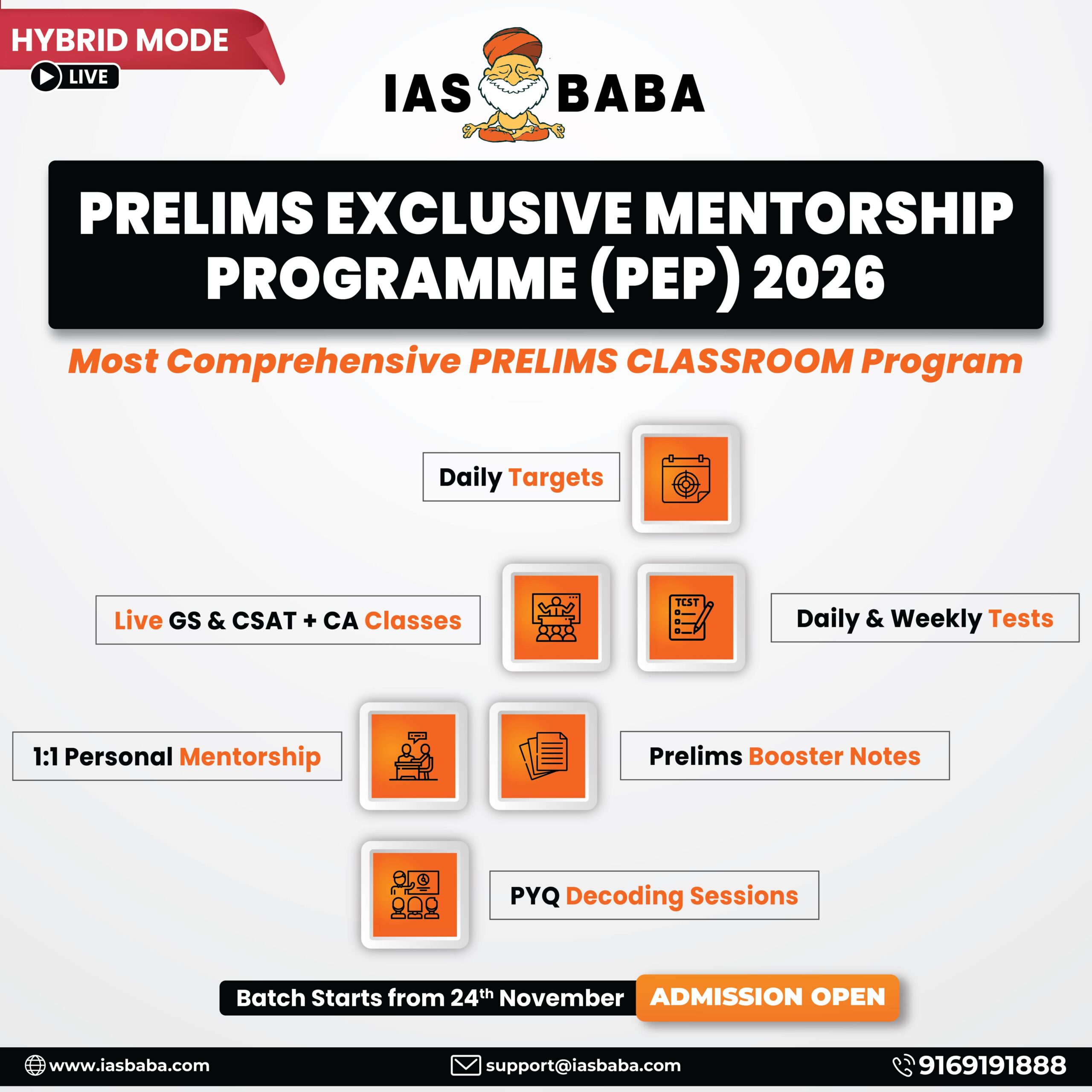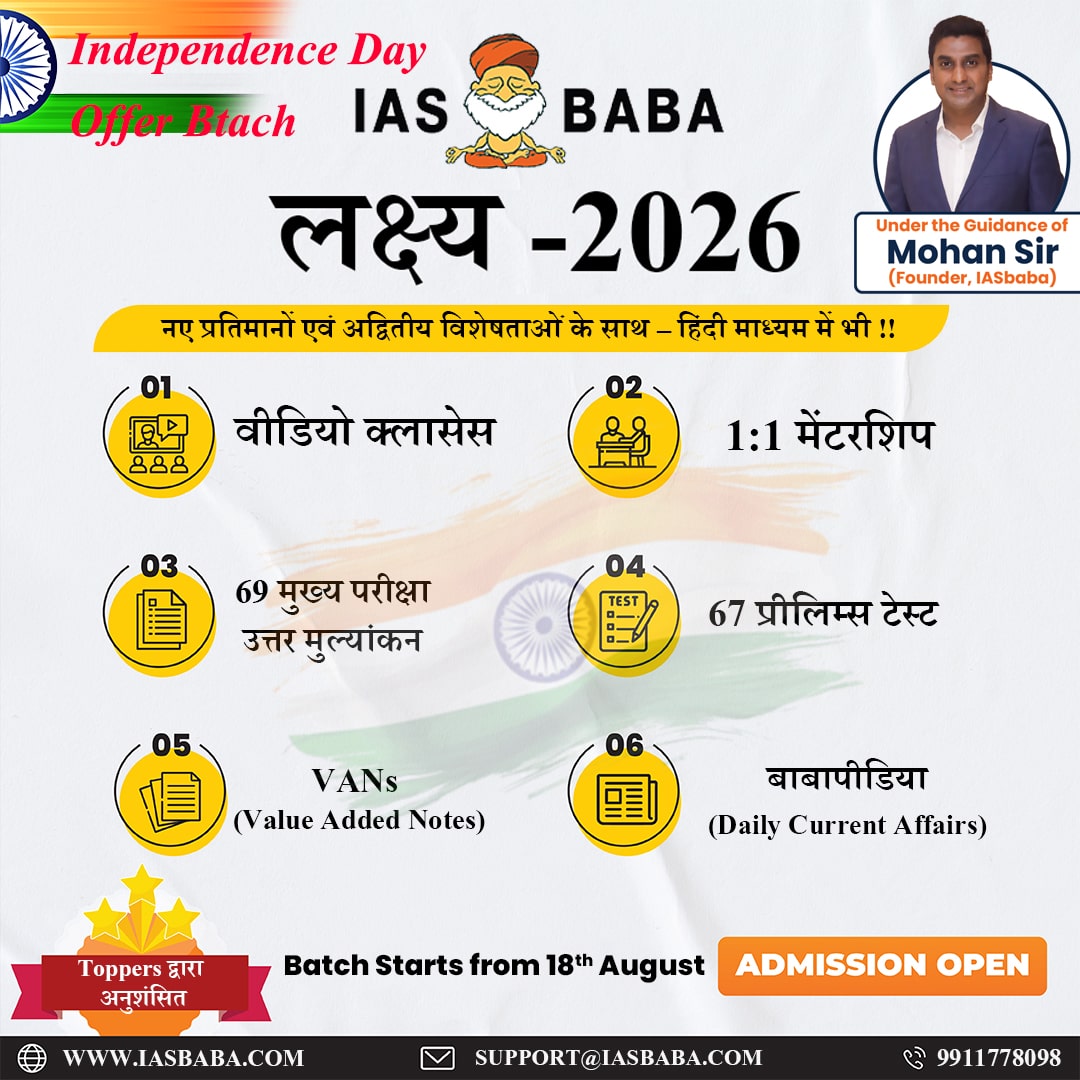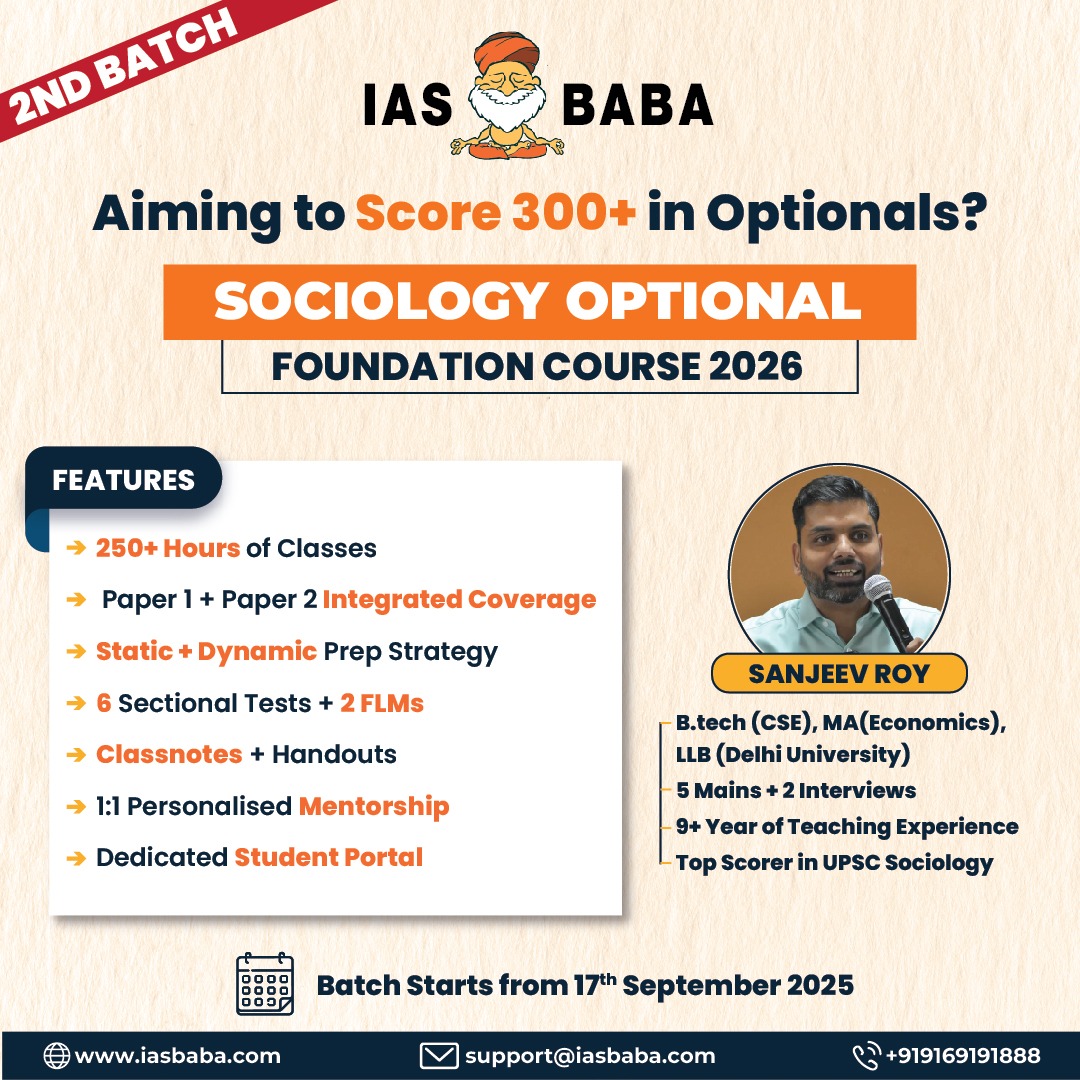IASbaba Daily Prelims Quiz
For Previous Daily Quiz (ARCHIVES) – CLICK HERE
The Current Affairs questions are based on sources like ‘The Hindu’, ‘Indian Express’ and ‘PIB’, which are very important sources for UPSC Prelims Exam. The questions are focused on both the concepts and facts. The topics covered here are generally different from what is being covered under ‘Daily Current Affairs/Daily News Analysis (DNA) and Daily Static Quiz’ to avoid duplication. The questions would be published from Monday to Saturday before 2 PM. One should not spend more than 10 minutes on this initiative.
Gear up and Make the Best Use of this initiative.
Do remember that, “the difference between Ordinary and EXTRA-Ordinary is PRACTICE!!”
Important Note:
- Don’t forget to post your marks in the comment section. Also, let us know if you enjoyed today’s test 🙂
- After completing the 5 questions, click on ‘View Questions’ to check your score, time taken, and solutions.
Test-summary
0 of 5 questions completed
Questions:
- 1
- 2
- 3
- 4
- 5
Information
To view Solutions, follow these instructions:
- Click on – ‘Start Test’ button
- Solve Questions
- Click on ‘Test Summary’ button
- Click on ‘Finish Test’ button
- Now click on ‘View Questions’ button – here you will see solutions and links.
You have already completed the test before. Hence you can not start it again.
Test is loading...
You must sign in or sign up to start the test.
You have to finish following test, to start this test:
Results
0 of 5 questions answered correctly
Your time:
Time has elapsed
You have scored 0 points out of 0 points, (0)
| Average score |
|
| Your score |
|
Categories
- Not categorized 0%
| Pos. | Name | Entered on | Points | Result |
|---|---|---|---|---|
| Table is loading | ||||
| No data available | ||||
- 1
- 2
- 3
- 4
- 5
- Answered
- Review
-
Question 1 of 5
1. Question
-
With reference to the Ramman festival of Garhwal, consider the following statements:
-
The right to perform the Narasimha mask-dance is hereditary and restricted to a specific Bhandari (Rajput) lineage
-
The festival includes Maal Nritya, a performance recalling local historical conflicts, distinct from the mythological episodes of the Ramayana.
-
The festival is transmitted orally without written choreography,
How many of the statements given above is/are correct?
Correct
-
Solution(c)
Explanation:
- The Narasimha mask-dance is performed hereditarily by a specific Bhandari (Rajput) lineage, and the festival date is formally declared by the village Brahmin priest. Hence Statement 1 is Correct
- Maal Nritya depicts local historical and community conflicts, making it distinct from the Ramayana-based ritual enactments within the festival. Hence Statement 2 is Correct
The festival is orally transmitted with no codified choreography, and was inscribed on the UNESCO Representative List in 2009 due to threats from migration and weakening traditional caste-linked performer roles. Hence Statement 3 is Correct
Incorrect
-
Solution(c)
Explanation:
- The Narasimha mask-dance is performed hereditarily by a specific Bhandari (Rajput) lineage, and the festival date is formally declared by the village Brahmin priest. Hence Statement 1 is Correct
- Maal Nritya depicts local historical and community conflicts, making it distinct from the Ramayana-based ritual enactments within the festival. Hence Statement 2 is Correct
The festival is orally transmitted with no codified choreography, and was inscribed on the UNESCO Representative List in 2009 due to threats from migration and weakening traditional caste-linked performer roles. Hence Statement 3 is Correct
-
-
Question 2 of 5
2. Question
-
Consider the following statements regarding the history of gold coinage in India:
-
The Kushanas were the first to issue gold coins on a large scale, showing Central Asian and Mediterranean cultural influences.
-
Gupta gold coins are noted for their high artistic refinement, supported by earlier long-distance trade networks.
-
Under the Delhi Sultanate, gold coinage expanded due to the growth of the Iqta revenue system.
How many of the statements given above is/are correct?
Correct
-
Solution(b)
Explanation:
- The Kushanas were the first to issue gold coins on a large scale in India, and their coin designs reflected Central Asian and Greco-Roman artistic influence. Hence Statement 1 is Correct
- Gupta gold coins are known for high artistic and technical refinement, and their abundance was supported by trade-linked economic prosperity that had developed earlier. Hence Statement 2 is Correct
During the Delhi Sultanate, gold coinage did not expand. Gold was relatively scarce, and the Sultanate primarily standardized the silver tanka and copper jital, not gold. Hence Statement 3 is Incorrect
Incorrect
-
Solution(b)
Explanation:
- The Kushanas were the first to issue gold coins on a large scale in India, and their coin designs reflected Central Asian and Greco-Roman artistic influence. Hence Statement 1 is Correct
- Gupta gold coins are known for high artistic and technical refinement, and their abundance was supported by trade-linked economic prosperity that had developed earlier. Hence Statement 2 is Correct
During the Delhi Sultanate, gold coinage did not expand. Gold was relatively scarce, and the Sultanate primarily standardized the silver tanka and copper jital, not gold. Hence Statement 3 is Incorrect
-
-
Question 3 of 5
3. Question
-
Consider the following statements regarding Food Fortification:
-
Food fortification addresses micronutrient deficiencies without requiring changes in eating habits or food intake.
-
Fortification is a long-term public health strategy as it works through staple foods and ensures wider, sustained reach, unlike supplementation.
Which of the statements given above is/are correct?
Correct
-
Solution(c)
Explanation:
- Food fortification is designed to reduce micronutrient deficiencies by adding nutrients to commonly consumed foods. Hence Statement 1 is Correct
It does not require people to change their diet or food intake patterns.
Fortification is considered a long-term population-level strategy, unlike supplementation which requires active compliance.
By targeting staple foods, fortification achieves wider and sustained reach over time. Hence Statement 2 is CorrectIncorrect
-
Solution(c)
Explanation:
- Food fortification is designed to reduce micronutrient deficiencies by adding nutrients to commonly consumed foods. Hence Statement 1 is Correct
It does not require people to change their diet or food intake patterns.
Fortification is considered a long-term population-level strategy, unlike supplementation which requires active compliance.
By targeting staple foods, fortification achieves wider and sustained reach over time. Hence Statement 2 is Correct -
-
Question 4 of 5
4. Question
-
Which of the following is NOT an indicator used in the QS Asia University Rankings?
Correct
-
Solution (d)
Explanation
QS Asia uses indicators such as:
- Academic reputation
- Employer reputation
- Faculty–student ratio
- International research network
- Citations per paper
- Faculty with PhD
- Inbound and outbound exchange students, etc.
Incorrect
-
Solution (d)
Explanation
QS Asia uses indicators such as:
- Academic reputation
- Employer reputation
- Faculty–student ratio
- International research network
- Citations per paper
- Faculty with PhD
- Inbound and outbound exchange students, etc.
-
-
Question 5 of 5
5. Question
-
With reference to the role of the Speaker under the Anti-Defection Law, consider the following statements:
-
The Speaker’s decision on questions of disqualification under the Tenth Schedule was initially considered final, but is now subject to judicial review.
-
The Supreme Court has suggested that an independent tribunal headed by a retired judge could replace the Speaker in deciding defection cases.
-
A time-limit is clearly prescribed in the Tenth Schedule for the Speaker to decide on disqualification petitions.
Which of the statements given above is/are correct?
Correct
-
Solution(a)
Explanation:
- The Speaker’s decision under the Tenth Schedule was earlier considered final, but in Kihoto Hollohan (1992), the Supreme Court held that the decision is subject to judicial review on grounds of mala fide or perversity. Hence Statement 1 is Correct
- In Keisham Meghachandra Singh (2020), the Supreme Court suggested that an independent tribunal headed by a retired judge may replace the Speaker to ensure neutrality in deciding disqualification cases. Hence Statement 2 is Correct
- The Tenth Schedule does not prescribe any specific time-limit for the Speaker to decide on disqualification petitions, leading to delays in several cases. Hence Statement 3 is Incorrect
Incorrect
-
Solution(a)
Explanation:
- The Speaker’s decision under the Tenth Schedule was earlier considered final, but in Kihoto Hollohan (1992), the Supreme Court held that the decision is subject to judicial review on grounds of mala fide or perversity. Hence Statement 1 is Correct
- In Keisham Meghachandra Singh (2020), the Supreme Court suggested that an independent tribunal headed by a retired judge may replace the Speaker to ensure neutrality in deciding disqualification cases. Hence Statement 2 is Correct
- The Tenth Schedule does not prescribe any specific time-limit for the Speaker to decide on disqualification petitions, leading to delays in several cases. Hence Statement 3 is Incorrect
-
- Current Affairs Quiz, IAS Daily Current Affairs Quiz, IAS UPSC Current Affairs Quiz, IAS UPSC Prelims Quiz, IASbaba's Current Affairs Prelims Quiz, IASbaba's Daily Quiz, IASbaba's UPSC Quiz, Prelims Current Affairs Quiz, UPSC Current Affairs Quiz, UPSC Current Affairs Quiz IASbaba, UPSC Daily Current Affair Quiz, UPSC IAS Daily Quiz













